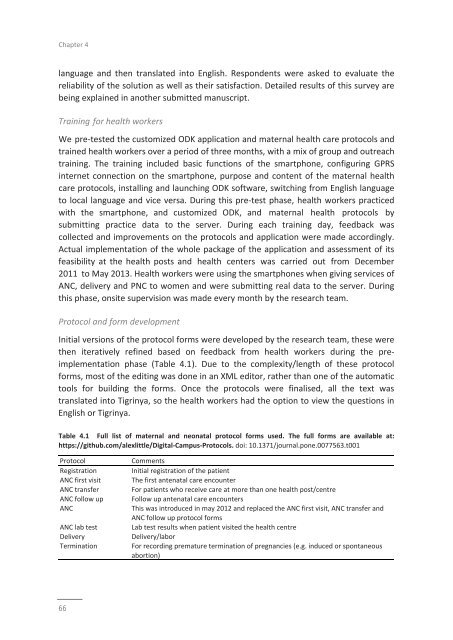araya-thesis
araya-thesis
araya-thesis
Create successful ePaper yourself
Turn your PDF publications into a flip-book with our unique Google optimized e-Paper software.
Chapter 4<br />
language and then translated into English. Respondents were asked to evaluate the<br />
reliability of the solution as well as their satisfaction. Detailed results of this survey are<br />
being explained in another submitted manuscript.<br />
Training for health workers<br />
We pre‐tested the customized ODK application and maternal health care protocols and<br />
trained health workers over a period of three months, with a mix of group and outreach<br />
training. The training included basic functions of the smartphone, configuring GPRS<br />
internet connection on the smartphone, purpose and content of the maternal health<br />
care protocols, installing and launching ODK software, switching from English language<br />
to local language and vice versa. During this pre‐test phase, health workers practiced<br />
with the smartphone, and customized ODK, and maternal health protocols by<br />
submitting practice data to the server. During each training day, feedback was<br />
collected and improvements on the protocols and application were made accordingly.<br />
Actual implementation of the whole package of the application and assessment of its<br />
feasibility at the health posts and health centers was carried out from December<br />
2011 to May 2013. Health workers were using the smartphones when giving services of<br />
ANC, delivery and PNC to women and were submitting real data to the server. During<br />
this phase, onsite supervision was made every month by the research team.<br />
Protocol and form development<br />
Initial versions of the protocol forms were developed by the research team, these were<br />
then iteratively refined based on feedback from health workers during the preimplementation<br />
phase (Table 4.1). Due to the complexity/length of these protocol<br />
forms, most of the editing was done in an XML editor, rather than one of the automatic<br />
tools for building the forms. Once the protocols were finalised, all the text was<br />
translated into Tigrinya, so the health workers had the option to view the questions in<br />
English or Tigrinya.<br />
Table 4.1 Full list of maternal and neonatal protocol forms used. The full forms are available at:<br />
https://github.com/alexlittle/Digital‐Campus‐Protocols. doi: 10.1371/journal.pone.0077563.t001<br />
Protocol<br />
Registration<br />
ANC first visit<br />
ANC transfer<br />
ANC follow up<br />
ANC<br />
ANC lab test<br />
Delivery<br />
Termination<br />
Comments<br />
Initial registration of the patient<br />
The first antenatal care encounter<br />
For patients who receive care at more than one health post/centre<br />
Follow up antenatal care encounters<br />
This was introduced in may 2012 and replaced the ANC first visit, ANC transfer and<br />
ANC follow up protocol forms<br />
Lab test results when patient visited the health centre<br />
Delivery/labor<br />
For recording premature termination of pregnancies (e.g. induced or spontaneous<br />
abortion)<br />
66


